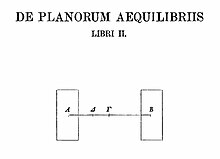
Back حول توازن السطوح Arabic על שיווי משקל של שטחים מישוריים HE Sull'equilibrio dei piani Italian O ravnovesju ravnin Slovenian
 | |
| Author | Archimedes |
|---|---|
| Language | Ancient Greek |
| Genre | Physics, Geometry |
On the Equilibrium of Planes (Ancient Greek: Περὶ ἐπιπέδων ἱσορροπιῶν, romanized: perí epipédōn isorropiôn) is a treatise by Archimedes in two books. The first book contains a proof of the law of the lever and culminates with propositions on the centre of gravity of the triangle and the trapezium.[1][2] The second book, which contains ten propositions, examines the centres of gravity of parabolic segments.[1]
According to Pappus of Alexandria, Archimedes' work on levers and his understanding of mechanical advantage caused him to say: "Give me a place to stand on, and I will move the Earth" (Ancient Greek: δός μοί ποῦ στῶ καὶ κινῶ τὴν γῆν, romanized: dṓs moi poû stṓ kaí kinô tḗn gên), though other ancient testimonia are ambiguous regarding the context of the saying.[3][4]
- ^ a b Heath, T.L. (1897). "The Works of Archimedes (1897). The unabridged work in PDF form (19 MB)". Cambridge University Press. Archived from the original on 6 October 2007. Retrieved 2013-01-06.
- ^ Berggren, J. L. (1976). "Spurious Theorems in Archimedes' Equilibrium of Planes Book I". Archive for History of Exact Sciences. 16 (2): 87–103. doi:10.1007/BF00349632. ISSN 1432-0657. S2CID 119741769.
- ^ Quoted by Pappus of Alexandria in Synagoge, Book VIII, p. 1060 in ed. Hultsch
- ^ Berryman, S. (2020). "How Archimedes Proposed to Move the Earth". Isis. 111 (3): 562–567. doi:10.1086/710317. ISSN 0021-1753. S2CID 224841008.